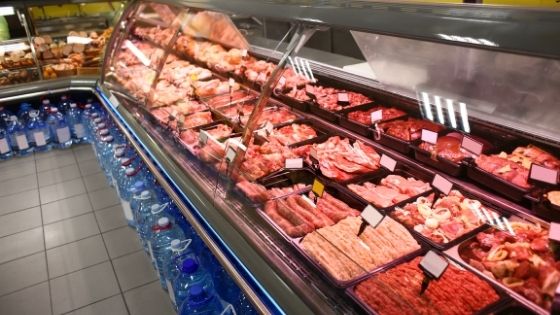You know that downtime for commercial refrigeration systems is not something you can afford if you own a restaurant, bar, or grocery store.
Walk-in freezers and coolers require a lot of moving parts and maintenance. We have compiled a comprehensive list of all things commercial refrigeration.
Continue reading to find energy-saving and best practices for commercial refrigeration systems.
Commercial Refrigeration System
A commercial refrigeration system is cold storage equipment that we use in commercial environments. You can find them in grocery stores, specialty food stores, and convenience stores.
A commercial refrigeration system would also include the walk-in freezers and refrigerators that we usually find in cafeterias and restaurant equipment.
Businesses and homeowners can store food and drinks for long periods of time without worrying about spoilage, thanks to refrigeration. Commercial refrigeration is for the purpose of keeping food and ingredients chilled by removing heat.
What are the different types of commercial refrigeration equipment?
We recommend a variety of commercial refrigeration systems:
- Reach-in vertical cabinets and refrigerators
- Plug-in enclosed vending machines
- Semi-vertical display cabinets
- Horizontal cases
- Deli cases
- Drop-in coolers
- Draft beer systems
- Under-counter refrigerators
- Back bar coolers
- Display cases for refrigerators
- Prep table
Each of the different types of commercial refrigeration equipment has a different function. Let’s take a look at the three most important examples.
Coolers
Coolers are used to keep food and drinks below their normal room temperature but above freezing. This equipment keeps perishable items cool and prevents them from spoiling.
Freezers
Freezers freeze perishable foods completely, which prevents them from spoiling. Freezing should be done for ice cream, microwavable foods, and other goods.
Combination of Coolers and Freezers
Combination commercial refrigeration units are capable of chilling or freezing perishable foods.
What industries require commercial refrigeration?
Commercial refrigeration is used by many industries and businesses. Commercial refrigeration system such as Wine Room Refrigeration Systems or Supermarket Refrigeration Systems is often required by food and beverage companies like wine companies, supermarkets, and convenience stores, as well as restaurants.
Commercial refrigeration is often used by hospitals and medical research centers to protect sensitive materials. Commercial refrigeration systems can also be found in florist shops. These systems are used to protect fresh-cut flowers against wilting.
You should be familiar with the operation of commercial refrigeration.
How do you choose?
When choosing a commercial refrigeration system, there are some things we need to consider:
- Space is essential
- Type of storage
- Cost.
Let’s take a closer look at each one.
First, measure the space available. Commercial refrigeration systems come in many sizes and shapes. Commercial refrigeration systems storage must be maximized.
There are many commercial refrigeration systems. Depending on the type of business, one’s choice of refrigeration system will vary. Display units are required for shops, while high-capacity freezers and refrigerators are needed for restaurants.
Two costs to consider when purchasing a new commercial refrigeration system:
- The initial cost and
- Operating costs.
The initial cost is the price paid to purchase and installs a system. Operating costs are generally the costs that result directly from the system being used.
Commercial refrigeration systems can handle larger loads and last for longer periods. Commercial refrigeration is required by some businesses:
- Companies that make food and beverages
- Supermarkets,
- Convenience shops, and
- Restaurants.
How does commercial refrigeration commercial work?
The Cooling Process
The Second Law of Thermodynamics is the basis of refrigeration. The Second Law of Thermodynamics states that heat travels from the warmer to the colder object when two objects with different temperatures are close to each other. Commercial refrigeration systems use a refrigerant solution in order to transfer heat from food stored within the refrigeration unit to the refrigerant.
The second principle that refrigerant solutions follow is that gases cool as they expand and heat up when they compress. The refrigerant goes through several pressure changes as it cycles through the refrigeration system. This improves efficiency and speeds up the process. It removes heat from the refrigeration system to keep it cool.
The Refrigerant
Modern commercial refrigeration systems are successful because they use refrigerants. Freon used to be the most commonly found refrigerant in refrigerators and air conditioners. Freon, however, was discovered to cause damage to the Earth’s ozone layer. This can lead to both increased solar radiation reaching the surface of the planet and global climate changes.
To improve the efficiency and environmental friendliness of modern refrigeration systems, other refrigerants like tetrafluoroethane are being used in their place.
The commercial refrigeration industry has grown to be a huge business. To chill the environment, it can be done at high temperatures.
Storage Foods & Beverages
The food business is dependent on freezers. Your entire business could be at risk if your refrigerating system is not working properly.
Installers, owners, and technicians who work with commercial refrigeration face many challenges. A new industrial freeze installation may be required, with all the necessary costs and networks.
Commercial refrigeration systems or Commercial Refrigerators use a circuit that uses an absorption system to cool or dry air. The general refrigeration principle converts liquids into gas and removes heat from surrounding areas. The commercial refrigeration compressor is one of the basic components of the refrigeration cycle.













